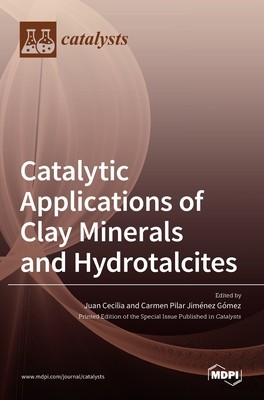
- We will send in 10–14 business days.
- Publisher: MDPI AG
- ISBN-10: 3036535527
- ISBN-13: 9783036535524
- Format: 17 x 24.4 x 1.1 cm, hardcover
- Language: English
- SAVE -10% with code: EXTRA
Catalytic Applications of Clay Minerals and Hydrotalcites (e-book) (used book) | bookbook.eu
Reviews
Description
Clay minerals are inexpensive and available materials with a wide range of applications (adsorbent, ion exchanger, support, catalyst, paper coating, ceramic, and pharmaceutical applications, among others). Clay minerals can be easily modified through acid/basic treatments, the insertion of bulky ions or pillars into the interlayer spacing, and acid treatment, improving their physicochemical properties.
Considering their low cost and high availability, clay minerals display a relatively high specific surface area in such a way that they have a great potential to be used as catalytic supports, since they can disperse expensive active phases as noble metals on the porous structures of their surfaces. In addition, the low cost of these supports allows their implementation on an industrial scale more easily than other supports, which are only feasible at the laboratory scale. Hydrotalcites (considered as anionic or basic clays) are also inexpensive materials with a great potential to be used as catalysts, since their textural properties could also be modified easily through the insertion of anions in their interlayer spacing. In the same way, these hydrotalcites, formed by layered double hydroxides, can lead to their respective mixed oxides after thermal treatment. These mixed oxides are considered basic catalysts with a high surface area, so they can also be used as catalytic support.
EXTRA 10 % discount with code: EXTRA
The promotion ends in 10d.19:27:07
The discount code is valid when purchasing from 10 €. Discounts do not stack.
- Publisher: MDPI AG
- ISBN-10: 3036535527
- ISBN-13: 9783036535524
- Format: 17 x 24.4 x 1.1 cm, hardcover
- Language: English English
Clay minerals are inexpensive and available materials with a wide range of applications (adsorbent, ion exchanger, support, catalyst, paper coating, ceramic, and pharmaceutical applications, among others). Clay minerals can be easily modified through acid/basic treatments, the insertion of bulky ions or pillars into the interlayer spacing, and acid treatment, improving their physicochemical properties.
Considering their low cost and high availability, clay minerals display a relatively high specific surface area in such a way that they have a great potential to be used as catalytic supports, since they can disperse expensive active phases as noble metals on the porous structures of their surfaces. In addition, the low cost of these supports allows their implementation on an industrial scale more easily than other supports, which are only feasible at the laboratory scale. Hydrotalcites (considered as anionic or basic clays) are also inexpensive materials with a great potential to be used as catalysts, since their textural properties could also be modified easily through the insertion of anions in their interlayer spacing. In the same way, these hydrotalcites, formed by layered double hydroxides, can lead to their respective mixed oxides after thermal treatment. These mixed oxides are considered basic catalysts with a high surface area, so they can also be used as catalytic support.


Reviews